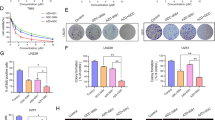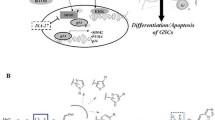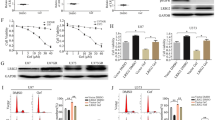Abstract
We have previously reported that combined inhibition of the epidermal growth factor receptor by erlotinib and of RAC1 by NSC23766 yielded a synergistic antiproliferative effect on established and primary cultured glioblastoma cells. The current study aimed at identifying the molecular mechanism. Staining for annexin V/PI or carboxyfluorescein succinimidyl ester was performed in order to determine the induction of apoptosis, necrosis or cytostasis in established and primary cultured glioblastoma cells. Moreover, expression of Ki-67 was determined by immunofluorescence, and the expression of cell cycle proteins was analysed by Western blot. Our data show that combined treatment with erlotinib and NSC23766 resulted in a reduced number of cell divisions, a significantly decreased Ki-67 expression, increased apoptosis and autophagy when compared to single agent treatments. On the molecular level, concomitant treatment with both agents resulted in a pronounced downregulation of cyclin D1, cyclin-dependent kinases 2, 4 and 6, as well as of survivin when compared to treatments with either agent alone. In conclusion, we demonstrate that combined treatment of human glioma cell lines in vitro with erlotinib and NSC23766 markedly inhibits cell division, induces apoptosis independent of caspase-3 activation and induces autophagy concomitant with suppression of survivin.






Similar content being viewed by others
References
Stupp R, Mason W, van den Bent M, Weller M, Fisher B, Taphoom M, Belanger K, Brandes A, Marosi C, Bogdahn U, Curschmann J, Janzer R, Ludwin S, Gorlia T, Allgeier A, Lacombe D, Cairncross J, Eisenhauer E, Mirimanoff R (2005) Radiotherapy plus concomitant and adjuvant temozolomide for glioblastoma. N Engl J Med 352:987–996
Karpel-Massler G, Schmidt U, Unterberg A, Halatsch M (2009) Therapeutic inhibition of the epidermal growth factor receptor in high-grade gliomas: where do we stand? Mol Cancer Res 7:1000–1012
Karpel-Massler G, Westhoff M-A, Kast R, Wirtz C, Halatsch M-E (2011) Erlotinib in glioblastoma: lost in translation? Anticancer Agents Med Chem 11:748–755
van den Bent M, Brandes A, Rampling R, Kouwenhoven M, Kros J, Carpentier A, Clement P, Frenay M, Campone M, Baurain J, Armand J, Taphoorn M, Tosoni A, Kletzl H, Klughammer B, Lacombe D, Gorlia T (2009) Randomized phase II trial of erlotinib versus temozolomide or carmustine in recurrent glioblastoma: EORTC brain tumor group study 26034. J Clin Oncol 27:1268–1274
Brown P, Krishnan S, Sarkaria J, Wu W, Jaeckle K, Uhm J, Geoffroy F, Arusell R, Kitange G, Jenkins R, Kugler J, Morton R, Rowland K, Mischel P, Yong W, Scheithauer B, Schiff D, Giannini C, Buckner J (2008) Phase I/II trial of erlotinib and temozolomide with radiation therapy in the treatment of newly diagnosed glioblastoma multiforme: North Central Cancer Treatment Group Study N0177. J Clin Oncol 26:5603–5609
Peereboom D, Shepard D, Ahluwalia M, Brewer C, Agarwal N, Stevens G, Suh J, Toms S, Vogelbaum M, Weil R, Elson P, Barnett G (2010) Phase II trial of erlotinib with temozolomide and radiation in patients with newly diagnosed glioblastoma multiforme. J Neurooncol 98:93–99
Karpel-Massler G, Westhoff M-A, Zhou S, Nonnenmacher L, Dwucet A, Kast R, Bachem M, Wirtz C, Debatin K-M, Halatsch M-E (2013) Combined inhibition of HER1/EGFR and RAC1 results in a synergistic antiproliferative effect on established and primary cultured human glioblastoma cells. Mol Cancer Ther 12:1783–1795
Arteaga C (2003) HER1/EGFR: a molecular approach to cancer therapy. Semin Oncol 30:3–14
Scagliotti G, Selvaggi G, Novello S, Hirsch F (2004) The biology of epidermal growth factor receptor in lung cancer. Clin Cancer Res 10:4227s–4232s
Didsbury J, Weber RF, Bokoch GM, Evans T, Snyderman R (1989) rac, a novel ras-related family of proteins that are botulinum toxin substrates. J Biol Chem 264:16378–16382
Etienne-Manneville S, Hall A (2002) Rho GTPases in cell biology. Nature 420:629–635
Chan AY, Coniglio SJ, Chuang YY, Michaelson D, Knaus UG, Philips MR, Symons M (2005) Roles of the Rac1 and Rac3 GTPases in human tumor cell invasion. Oncogene 24:7821–7829
Jung IH, Leem GL, Jung DE, Kim MH, Kim EY, Kim SH, Park HC, Park SW (2013) Glioma is formed by active Akt1 alone and promoted by active Rac1 in transgenic zebrafish. Neuro Oncol 15:290–304
Reyes SB, Narayanan AS, Lee HS, Tchaicha JH, Aldape KD, Lang FF, Tolias KF, McCarty JH (2013) alphavbeta8 integrin interacts with RhoGDI1 to regulate Rac1 and Cdc42 activation and drive glioblastoma cell invasion. Mol Biol Cell 24:474–482
Senger D, Tudan C, Guiot M-C, Mazzoni I, Molenkamp G, LeBlanc R, Antel J, Olivier A, Snipes G, Kaplan D (2002) Suppression of Rac activity induces apoptosis of human glioma cells but not normal human astrocytes. Cancer Res 62:2131–2140
Yoon CH, Hyun KH, Kim RK, Lee H, Lim EJ, Chung HY, An S, Park MJ, Suh Y, Kim MJ, Lee SJ (2011) The small GTPase Rac1 is involved in the maintenance of stemness and malignancies in glioma stem-like cells. FEBS Lett 585:2331–2338
Gao Y, Dickerson JB, Guo F, Zheng J, Zheng Y (2004) Rational design and characterization of a Rac GTPase-specific small molecule inhibitor. Proc Natl Acad Sci U S A 101:7618–7623
Opel D, Westhoff MA, Bender A, Braun V, Debatin KM, Fulda S (2008) Phosphatidylinositol 3-kinase inhibition broadly sensitizes glioblastoma cells to death receptor-and drug-induced apoptosis. Cancer Res 68:6271–6280
Hug H, Los M, Hirt W, Debatin KM (1999) Rhodamine 110-linked amino acids and peptides as substrates to measure caspase activity upon apoptosis induction in intact cells. BioChemistry 38:13906–13911
Chang YJ, Li LT, Chen HA, Hung CS, Wei PL (2014) Silencing survivin activates autophagy as an alternative survival pathway in HCC cells. Tumour Biol 35:9957–9966
Wang Q, Chen Z, Diao X, Huang S (2011) Induction of autophagy-dependent apoptosis by the survivin suppressant YM155 in prostate cancer cells. Cancer Lett 302:29–36
Wang YF, Zhang W, He KF, Liu B, Zhang L, Zhang WF, Kulkarni AB, Zhao YF, Sun ZJ (2014) Induction of autophagy-dependent cell death by the survivin suppressant YM155 in salivary adenoid cystic carcinoma. Apoptosis 19:748–758
Rixe O, Fojo T (2007) Is cell death a critical end point for anticancer therapies or is cytostasis sufficient? Clin Cancer Res 24:7280–7287
Altieri DC (2003) Survivin, versatile modulation of cell division and apoptosis in cancer. Oncogene 22:8581–8589
Asanuma H, Torigoe T, Kamiguchi K, Hirohashi Y, Ohmura T, Hirata K, Sato M, Sato N (2005) Survivin expression is regulated by coexpression of human epidermal growth factor receptor 2 and epidermal growth factor receptor via phosphatidylinositol 3-kinase/AKT signaling pathway in breast cancer cells. Cancer Res 65:11018–11025
Jane EP, Premkumar DR, DiDomenico JD, Hu B, Cheng SY, Pollack IF (2013) YM-155 potentiates the effect of ABT-737 in malignant human glioma cells via survivin and Mcl-1 downregulation in an EGFR-dependent context. Mol Cancer Ther 12:326–338
Yoshida T, Zhang Y, Rivera Rosado LA, Chen J, Khan T, Moon SY, Zhang B (2010) Blockade of Rac1 activity induces G1 cell cycle arrest or apoptosis in breast cancer cells through downregulation of cyclin D1, survivin, and X-linked inhibitor of apoptosis protein. Mol Cancer Ther 9:1657–1668
Acknowledgements
This work was supported by a young investigator’s grant provided by Ulm Medical School and a scholarship of the Dr. Mildred Scheel foundation of the German Cancer Aid to GKM. We thank Angelika Vollmer, Andrea Dittrich and Susanne Baumgart for providing excellent technical assistance.
Author information
Authors and Affiliations
Corresponding author
Ethics declarations
Conflict of interest
All authors declare that they have no conflicts of interest.
Electronic supplementary material
Below is the link to the electronic supplementary material.
Rights and permissions
About this article
Cite this article
Karpel-Massler, G., Westhoff, MA., Kast, R.E. et al. Simultaneous Interference with HER1/EGFR and RAC1 Signaling Drives Cytostasis and Suppression of Survivin in Human Glioma Cells in Vitro. Neurochem Res 42, 1543–1554 (2017). https://doi.org/10.1007/s11064-017-2213-0
Received:
Revised:
Accepted:
Published:
Issue Date:
DOI: https://doi.org/10.1007/s11064-017-2213-0




